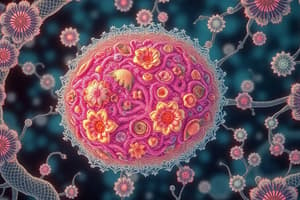Podcast
Questions and Answers
What features of sperm cells enable them to successfully fertilise an ovum?
What features of sperm cells enable them to successfully fertilise an ovum?
Sperm cells have a tail for swimming and many mitochondria for energy.
How do red blood cells maximize their oxygen-carrying capacity?
How do red blood cells maximize their oxygen-carrying capacity?
They lack a nucleus and contain haemoglobin for oxygen binding.
Explain the primary adaptations of muscle cells for their function.
Explain the primary adaptations of muscle cells for their function.
Muscle cells contain protein fibres for contraction and many mitochondria for energy.
What structural adaptations do nerve cells have to transmit electrical impulses effectively?
What structural adaptations do nerve cells have to transmit electrical impulses effectively?
Describe how root hair cells facilitate the absorption of water and minerals.
Describe how root hair cells facilitate the absorption of water and minerals.
What role do chloroplasts play in palisade cells, and how are they adapted for that role?
What role do chloroplasts play in palisade cells, and how are they adapted for that role?
Why do animal cells generally differentiate at an early stage, while plant cells can differentiate throughout their life?
Why do animal cells generally differentiate at an early stage, while plant cells can differentiate throughout their life?
How does the flat bi-concave shape of red blood cells benefit their function?
How does the flat bi-concave shape of red blood cells benefit their function?
What is the significance of having lots of mitochondria in muscle cells?
What is the significance of having lots of mitochondria in muscle cells?
Identify one key adaptation of palisade cells that aids in maximizing their photosynthetic efficiency.
Identify one key adaptation of palisade cells that aids in maximizing their photosynthetic efficiency.
Study Notes
Eukaryotic Cells
- Eukaryotic cells contain DNA organized into chromosomes housed within a nucleus.
- Animal cells possess features such as a nucleus, small vacuoles, cytoplasm, ribosomes, and various organelles including mitochondria and the Golgi apparatus.
- Plant cells have additional structures like a cell wall, large central vacuole, and chloroplasts for photosynthesis.
Comparison of Cell Types
- Animal cells lack cell walls and chloroplasts, while plant cells contain both.
- Prokaryotic cells (e.g., bacteria) are smaller than eukaryotic cells and possess no nucleus; their DNA is in a single loop.
- Prokaryotic cells also have plasmids, which are small, circular DNA fragments.
Microscopes
- Light Microscope:
- Uses light for imaging, allowing viewing of living samples, but offers low magnification (up to 200 nm resolution).
- Electron Microscope:
- Utilizes electron beams for high magnification and resolution (up to 0.1 nm), but cannot view living samples.
Specialised Cells
- Cells in both animals and plants differentiate to perform specific functions.
- Examples of specialized cells include:
- Sperm Cells: Adapted with a tail for swimming and numerous mitochondria for energy.
- Red Blood Cells: Lack a nucleus, contain hemoglobin for oxygen transport, and have a bi-concave shape for maximum surface area.
- Muscle Cells: Feature protein fibers for contraction and many mitochondria for energy.
- Nerve Cells: Have branched endings (dendrites) for connections and a myelin sheath for faster impulse transmission.
- Root Hair Cells: Have elongated structures to increase absorption surface area for water and minerals.
- Palisade Cells: Packed with chloroplasts for optimal light absorption in photosynthesis.
Key Terms
- Cell Membrane: Semi-permeable barrier surrounding the cell.
- Cell Wall: Rigid outer layer in plant cells providing structural support.
- Chloroplast: Organelle in plant cells for photosynthesis.
- Chromosome: DNA structure within the nucleus.
- Cytoplasm: Gel-like substance within the cell.
- DNA: Genetic material of the cell.
- Eukaryotic: Organisms with complex cells containing a nucleus.
- Magnification: Increase in apparent size of an object.
- Mitochondria: Energy-producing organelles.
- Nucleus: Control center of the cell housing DNA.
- Permanent Vacuole: Fluid-filled sac in plant cells for storage and maintaining pressure.
- Plasmid: Small loop of DNA in prokaryotes.
- Prokaryotic: Organisms with simpler cells without a nucleus.
- Resolution: Ability to distinguish two separate points in an image.
- Ribosome: Site of protein synthesis in the cell.
Studying That Suits You
Use AI to generate personalized quizzes and flashcards to suit your learning preferences.
Description
Test your knowledge on the structure of eukaryotic cells, including differences between animal and plant cells. This quiz covers essential organelles and their functions. Perfect for biology students studying cell biology.




